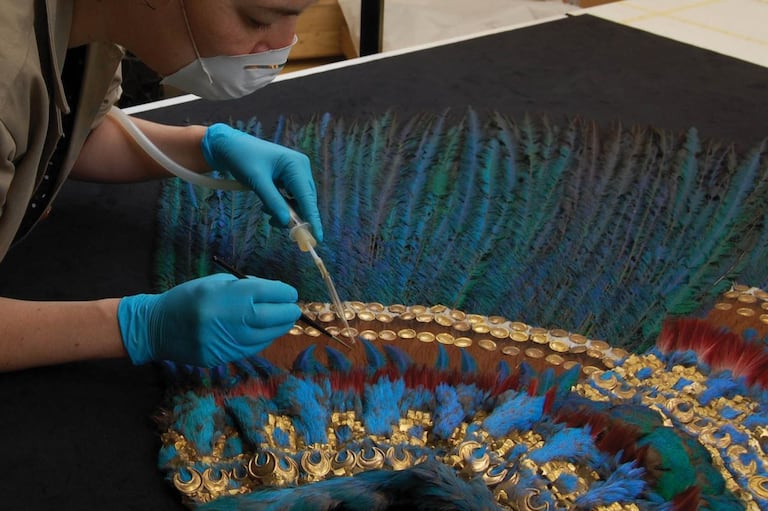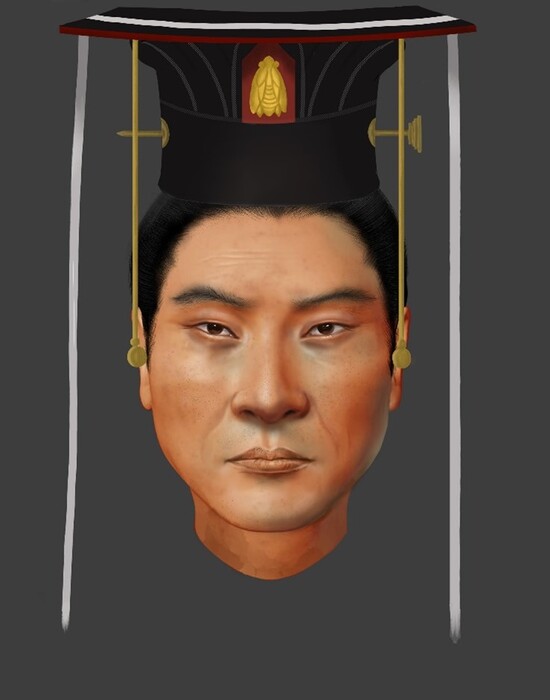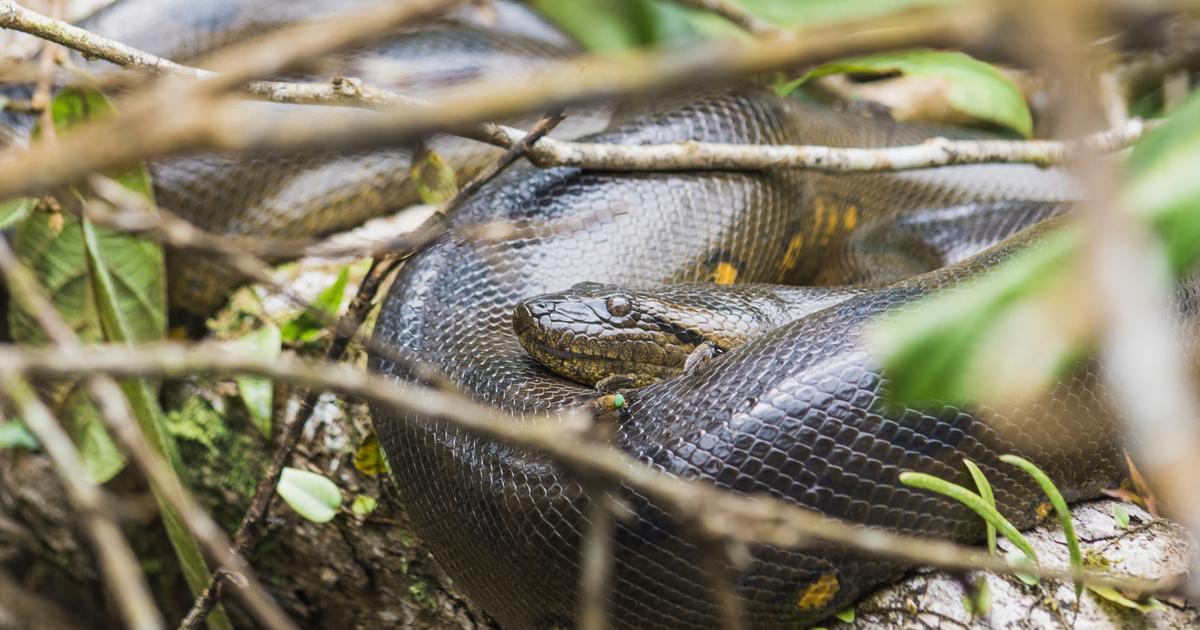Restoration work on the Plume of Moctezuma, in the Museum of Ethnology in Vienna, Cuartoscuro
About 500 years ago, a feathered headdress, made with pieces of gold, left Mexica territory and, in some way that experts still do not know for sure, reached Austria.
"The great Moctezuma (...) gave little things of gold and three loads of blankets rich in feathers," wrote the conqueror Bernal Díaz de Castillo, who arrived in those lands with Hernán Cortés in 1519. Although it is not safe that this piece, known as the Moctezuma plume, was in that shipment.
The journey that the Mesoamerican treasure made until it reached the collection of Archduke Ferdinand II, where it was located almost 80 years after the Spanish took over the Aztec empire, is still a mystery to scientists.
The truth is that five centuries later, the object is exhibited inside a sealed showcase in Vienna more than 10,000 kilometers from the North American country, like thousands of other ancient artifacts scattered abroad.
Since 2011, some 45,000 Mexicans have visited it for free, according to museum data.
The Mexican Government has claimed on different occasions the archaeological piece of enormous cultural and political value.
The last time was on October 12, when historian Beatriz Gutiérrez Müller asked the current president of Austria, Alexander Van der Bellen, entrusted by her husband, Andrés Manuel López Obrador.
The president acknowledged that recovering the "looted" heritage was an "almost impossible mission" because, according to him, "they have completely appropriated it."
"And it is really an impossible mission, but there are options to share the cultural heritage without having to move it", defends Sabine Haag, director of the Vienna Museum of Art History, on which the World Museum depends, where the headdress remains.
Haag responds to EL PAÍS from Vienna, together with the curator of the North and Central American collections of the World Museum, Gerard Van Bussel: "If you move it, it will be damaged and nobody wants that."
Question
.
What makes the plume so fragile?
Gerard van Bussel.
First of all, its age: it is probably over 500 years old.
In addition, it is made mainly of organic material, such as feathers, and has more than 1,500 small pieces of gold and silver.
These organic and inorganic materials rub against each other.
In all these years it has become really fragile.
P
.
What is the importance of the plume within the museum's permanent collection?
Sabine Haag.
It is one of the icons of the World Museum.
It is very popular.
The ancient plume is perhaps
the
object within the collection.
P
.
Do you think you will be able to return to Mexico at some point?
Sabine Haag.
Our responsibility is to take care of the piece and preserve it, to show it to the public, not only to this generation, but also to future generations.
Between 2010 and 2012, the binational team that studied the object agreed that, for now, unless you can teleport it, like in
Star Trek
, the artifact cannot move.
We do our best to publicize it and make it accessible.
And we do it in contact with our colleagues and friends in Mexico, to share it without having to move it.
P
.
Should I go back?
Sabine Haag.
That is a different question.
The point is: it cannot move.
Answering that question would be talking about a possibility that does not exist.
We haven't even moved it to the galleries where the show about the Aztecs [which opened this month] is exhibited.
Have you had a chance to see the original?
When you stand in front, it is a magical moment.
When you look at the plume through the glass it is possible to see its fragility.
Gerard van Bussel.
The stakes are too high.
Right now, we can't move it because we can't compensate for vibrations by road, by air, or across the Atlantic.
The feathers are really worn.
Especially the long quetzal feathers, which are very delicate.
We made a special display case to preserve it and, for example, if there is an earthquake in Vienna the box compensates for the vibrations and the plume does not move.
P
.
Couldn't it move inside that box across the Atlantic?
Gerard van Bussel.
The box is embedded in the floor.
P
.
What would be the best solution in this case?
Sabine Haag.
The president of Mexico spoke of an "almost impossible mission" when he introduced the possibility of a loan.
And it is truly a mission impossible, but there are options to share cultural heritage without having to move it.
Because if you move it it will be damaged and nobody wants that
.
P
.
What care does it require?
Gerard van Bussel.
It does not require too much.
You have to leave him alone, in peace.
We look at the temperature, the humidity, the light ... everything.
Everything is recorded and as soon as something changes we can correct it.
But most museum pieces are best left alone, in peace, and not moved.
The plume was 200 years in a glass case in the Castle of Ambras, in Tirol.
At the beginning of the 19th century, it was transferred to Vienna and exhibited in the Belvedere Palace.
It didn't really move.
And that is perhaps one of the reasons why it survived.
Many other plumes were brought to Europe in the 16th century.
They have disappeared because they were moved and thus they deteriorated.
Sabine Haag.
The biggest conservation work has already been done [between 2010 and 2012].
It's in the best shape it can be.
P
.
What do you think about the media and political uproar caused by Beatriz Gutiérrez Müller's loan request for the plume?
Sabine Haag.
It is no surprise that the plume is very special to Mexican citizens, as it is to us as well.
The piece has been in Europe for a long time, for more than 450 years.
It means a lot to our cultural heritage.
We do our best to share it, to display it with pride, to contextualize it ... Unfortunately it is the only surviving specimen.
Q.
What is it worth to the Austrians?
Gerard van Bussel.
Well, it means different things to different Austrians, of course.
But everyone in Austria knows him because he appears frequently in the newspapers.
When the Mexican president claimed it, all the Austrian newspapers published the news.
And it was not the first time, there are frequently discussions about the plume because it has been here so long that it has become part of the Austrian culture as well.
It is one of the most famous pieces in Vienna.
Sabine Haag
.
Archduke Ferdinand of Tirol was the creator of one of the
most important
kunstkammer
, a chamber of wonders.
He had it in his castle near Innsbruck.
After his death, the plume was identified in the inventory of his collection, which was published in 1596. It has been documented for more than 400 years in a collection of this type, in which non-European pieces played a very important role.
That collection began in the middle of the 16th century, when the world, more or less, was open to Europeans.
And of course, this is also part of the cultural heritage of the Austrians, their DNA, and their history.
This is very important to understand that this piece, like other pieces, are part of the cultural identity of our country.
We see it as a very, very important part of the world's cultural heritage.
P
.
Has Austria returned pieces as valuable as this in the past?
Gerard van Bussel.
It has happened and it does happen, yes.
We also do that.
For example, with New Zealand.
We are not prisons for artifacts.
If we can, we help communities to recover their heritage, if they want.
We are institutions to preserve art.
Discussions and new questions arise all the time, and we are open.
Sabine Haag.
It is a very complex matter.
It is not as simple as black or white.
The most important thing when facing this question is to speak with the communities, with the other country.
Not always the only solution is to return the objects because once they return to their country of origin they leave a void in the history of collecting, say, in Europe, or America, or wherever.
The mission of a museum is to preserve, which means you have to have the facilities.
We believe that the plume still exists because we have cared for it.
This is a dialogue that started some time ago and there is no single answer that solves all the questions.
P
.
Are you afraid that if the plume leaves Austria it will not return?
Sabine Haag
.
Well, you can't go.
That is not the question.
Not one that the museum can answer, because the museum does not own the piece.
The owner is the Republic of Austria.
All the objects in the museum have been given to us by the State together with the permission and responsibility to care for them, to teach them, to publicize them, to investigate them ... but they do not belong to us.
We have to take many measures to preserve the headdress, but we do this with every other piece in the museum.
The rest of the aspects do not fall within our field of competence.
Q.
It is not clear that the plume belonged to Moctezuma.
In fact, some experts believe that it could have belonged to a priest.
Why is it known in Mexico by that name: the Moctezuma plume?
Gerard van Bussel
.
We cannot answer for all Mexicans.
There are many Austrians who call it that too.
But there is no proof, no indication that the plume was connected to Moctezuma.
It appears in 1596 in the palace of Archduke Ferdinand II of Tirol, in an inventory.
That is 75 years after the fall of Mexico-Tenochtitlan.
We do not know when or how it got there, there are no documents.
We do not know how it was obtained.
So there is no reason to connect him with Moctezuma, or Hernán Cortés, or Carlos V. Those are just stories.









